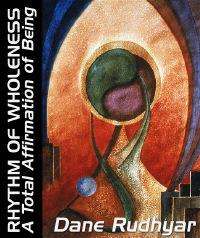 |
| Home | Bio | Art | Music | Literature | Civilization & Culture | Philosophy of Wholeness | Theosophy & Spirituality | Astrology |

RHYTHM OF WHOLENESS A Total Affirmation of Being by Dane Rudhyar, 1983 CONTENTS PROLOGUE PART ONE The Philosophy of Operative Wholeness 1. Prelude to a New Interpretation of Reality 2. The Search for Spiritual Security: The One, the Whole, and Wholeness 3. The Movement of Wholeness Page 1 Page 2 Page 3 Page 4 Page 5 PART TWO The Cycle of Being 4. The Structure of the Cycle of Being 5. The Four Crucial Phases of the Cycle of Being 6. The Inevitability of Success and Failure 7. Spirit and Mind PART THREE The Cycle of Man 8. Constitution of Man - The Physical and Psychic Bodies 9. Constitution of Man - The Spiritual Entity and the Higher Mind 10. The Structure and Transformation of the Total Person 11. The Cyclic Process of Spiritual Embodiment PART FOUR In The Spirit of Wholeness 12. The Principle of Holarchy and the Interplay of Horizontal and Vertical Relationships 13. Transpersonal Activity versus Mediumship 14. Rites of Passage EPILOGUE |

CHAPTER THREE
The Movement of Wholeness - 3 The Movement of Wholeness as the all-inclusive cycle of being Living a rhythmic, unhurried, and steady existence illumined by a realization of meaning and value thus depends on the scope and inclusiveness of the frame of reference accepted by an individual — and even more basically in most cases by the culture to which he or she belongs. For this frame of reference is a determining factor in the relation between a clearly defined, repetitive section of the continuum of change and the number (and level) of the activities he or she has or wants to perform during that period. For members of the human species living in tune with the rhythms of their natural habitat, the primordial and most fundamental repetitive, section of the continuum is the period defined by the daily rotation of the earth. This section divides itself into two more or less symmetrical periods, the day and the night. At the strictly biological level, each period is related to a specific mode of existence and type of activity and consciousness. There is a predominantly objective type based on the multifarious experiencing and working out of relationships (to a variety of objects and living beings as well as persons). Then follows (and precedes) a predominantly subjective type manifesting especially as sleep or, more generally, as rest and recovery from the stress and strain of physical (and/or mental) activity during the day-period. When agriculture and animal husbandry became dominant concerns for stable communities, the cycle of the year, symbolized as well as measured by the calendar, came to control a larger schedule of activities. This cycle (established by the revolution of the earth around the sun) was subdivided naturally by the cyclic changes in the appearance of the moon — changes which were believed to affect deeply the processes of life (and even, later on, of personality unfoldment). Out of the combination of larger and smaller cycles, and of other periodic changes in the nocturnal skies, astrology was born. It served as an interpretation of the meaning of changes which could be referred to yearly biological cycles, and later to longer cycles in which the recurrent conjunctions and oppositions of planets, especially Jupiter and Saturn, acted as markers of time. The one great value of astrology is that it provides an interpretation of cycles of time which does not, of itself, imply that one half of the cycle is positive and the other negative. The repetitive cyclic pattern is produced by the interplay of two forces that are assumed to be equally significant; what changes cyclically is their relationship. The relationship between two forces interacting within a whole of time generates constantly changing situations. The change is structured by the cyclic workings of the relationship. How the change manifests in terms of actual, experienced events is not revealed by the structure of change. An immense variety of events is possible, but their sequence and serial character are relatively permanent factors. They are relative because large and small cycles and sub-cycles always are interrelated, and because the interference of forces or entities operating in tune with higher magnitude (more inclusive) cycles in the occurrences of less inclusive ones is a possibility that should not be ignored (as we shall see in Chapter 12). Astrology became widely misused because its cyclic foundation was not understood or was conveniently ignored by those who were concerned only with predicting existential events and favorable or unfavorable times to perform definite acts. The situation is actually the reverse; for what the knowledge of cyclic structure may reveal is what a particular phase of a cycle calls for in terms of types of events, rather than whether a brief, passing moment (or more broadly a particular phase) is favorable for a particular action. Astrology essentially deals with the structure of cycles — of wholes of time — not with concrete events. Moreover, it deals with time (as I have defined this term), not with the continuum of change itself, because the astrologer can be aware of this continuum only from the point of view of a human being on the surface of the earth. Moreover, the astrologer's awareness also is conditioned (in most instances) by the culture's particular approach to change and by the approach inherent in his or her temperament and personal character. The condemnation of astrology by the councils and officialdom of the Christian world logically followed that of any cyclic interpretation of human existence and spiritual destiny. Instead, existence came to be considered a "historical" process starting with the creation of the world and ending in a glorious consummation, which Teilhard de Chardin envisioned as a supreme moment of total incandescence and spiritual oneness with the glorious Christ. At the individual level, existence was thought to begin with birth — a totally new beginning for a newly created soul — and to end in a death leading to a timeless ("eternal") blessedness, or perhaps to total failure in hell. History was conceived, ideally, as a one-directional process of spiritualization. But most historians of today are not concerned with the entire one-way process, leading up or down; they are interested only in gathering a mass of information about existential events which (they assume) reveal the mood of a particular generation, at most of a century, in a particular culture and religion (as James Joyce in Ulysses was concerned only with one day in the life of an ordinary man). Arnold Toynbee's attempt to discover a cyclic pattern in the structural development of "civilization" is now considered fanciful and unrealistic. Nevertheless, the fundamental question is always, what is reality? For the materialist, it is a basically random sequence of events having no meaning in themselves or in relation to one another and leading to an unknown, perhaps unknowable conclusion some billions of years hence. For the mystical philosopher, reality is "Now" — all appearances absorbed into an ineffable, changeless state of unity. For every human being facing the unceasing continuum of change in the spirit of the philosophy of operative Wholeness presented in this book, reality is the Movement of Wholeness; it is the cycle of being, the foundation of the complex interplay of elements and ceaseless transformations of which what we call bodily existence is but a phase. The hours of daytime also are but phases of the total situation caused by the rotation of the earth; and spring and winter, phases of the yearly cycle of seasons. Each noon presents to the consciousness at least slightly different causations, contacts, or feelings; the rose of this spring is not the same rose as that of a year ago. Yet the cyclic appearance of green leaves and rosebuds in the well-kept garden, and the fall of fragrant petals and brown leaves, can be understood on the basis of an annual process of growth and decay — and only on such a basis. What is understood, however, is the structure of the process. The knowledge of cycles of change is a structural type of knowledge. It does not reveal the details of existential facts or "actual" events, only the way they are related sequentially to one another and (what is more) related to a much larger cycle of being. In the case of the roses this would be the cycle of vegetation produced by the rotating motion of the earth, which is a planetary (not merely biological) factor. The cycle of being of which this book speaks is the largest conceivable cycle of activity; not only of activity but also of consciousness. All wholes of activity possess a degree of consciousness. There is no absolute non-consciousness, any more than there is nonbeing or non-motion. Change necessarily implies motion, provided we do not limit the concept of motion to physical motion in an objective, measurable space. In this sense change is unceasing. It is, I repeat, a continuum of motion; but the consciousness of every whole reacts to and interprets this continuum according to its own particular nature and capacity to interpret, understand, and attribute meaning. Every whole of being makes of such a continuum a structured series of repetitive changes, a series limited by the beginning and end of the integrated existence of the whole. When human consciousness is dominated by, because it is an expression of, biological processes, birth and death are the beginning and end of an integrated condition of wholeness at the physical level of earthly existence. The development of socio-cultural and mental activities adds the realization of personhood to that of conscious being as a physical organism. But according to the collective mentality of Western society, the feeling-realization of being a person also begins at physical birth and ends at physical death. For some Western religious minds, this death is followed by a mysterious and essentially incomprehensible state of being which never ends. This state is one of absorption in or total rejection by (in hell, as a state of being) a God whose being is ineffably and incomprehensibly beyond change, even if (irrationally!) He also is believed to be able to act yet remain absolutely unaffected by His actions. From such a point of view, one cannot speak meaningfully of a cycle of being, only of a progressive development from a period of formation "out of nothing" (ex nihilo) to a state of more or less absolute transcendence of existence as an integral whole. By permission of Leyla Rudhyar Hill Copyright © 1983 by Dane Rudhyar All Rights Reserved.  Web design and all data, text and graphics appearing on this site are protected by US and International Copyright and are not to be reproduced, distributed, circulated, offered for sale, or given away, in any form, by any means, electronic or conventional. See Notices for full copyright statement and conditions of use. Web design copyright © 2000-2004 by Michael R. Meyer. All Rights Reserved. |
 |